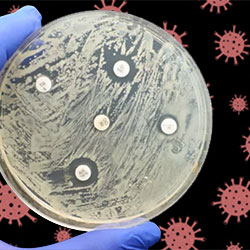By Aaron Tallent
Antimicrobial resistance (AMR) was a worldwide health threat before the pandemic, but what impact did COVID-19 have on AMR? The evidence indicates nothing good, according to speakers at ASM Microbe, in Washington, D.C.

“Our work suggests that COVID-19 patients could potentially represent an important reservoir for antimicrobial resistance and accelerate that already concerning public health threat,” said Bradley Langford, PharmD, BCIDP, a pharmacist specialist at Public Health Ontario and an antimicrobial stewardship pharmacist at Hotel Dieu Shaver Health and Rehabilitation Centre, in St. Catharines, Ontario. “It also reinforces the importance of the ongoing need for surveillance, as well as antimicrobial stewardship in the context of COVID-19.”
According to his team’s work, almost three-fourths of patients with COVID-19 received an antibiotic, which could increase the risk for resistance in these patients and the broader population. Antibiotics are commonly used because of diagnostic uncertainty and the concern for coinfection and secondary infection (Clin Microbiol Infect 2021;27[4]:520-531).
Last year, researchers analyzed 171 studies from December 2019 to October 2020, with bacterial infection data from 171,262 patients, Dr. Langford said. They found overall bacterial coinfection in patients with COVID-19 was relatively low at 5.1%, but it was higher in patients who were hospitalized in the ICU. Of the ICU patients, 15.4% experienced a coinfection and 41.9% had a secondary infection, which occurred at least 48 hours after admission for COVID-19. Both ICU stay and mechanical ventilation were predictors of bacterial infection (Clin Microbiol Infect 2022 Nov 26. doi:https://doi.org/10.1016/j.cmi.2021.11.008).
“We saw that for every 10% increase in the population being mechanically ventilated, there was a 25% to 45% increase in the odds of coinfection or secondary infection,” Dr. Langford said.
Some of the most common bacterial organisms isolated in this study were Staphylococcus aureus and Klebsiella species. Another study presented at the ASM Microbe session examined the emergence of a K. pneumoniae (KPN) sequence type (ST) 307, an antimicrobial drug–resistant clone, in Argentina. KPN ST307 emerged during the 1990s and has been the cause of many healthcare-associated infections.
“It has global distribution with countries that have this sequence type in endemic regions. It has also been reported in hospital outbreaks and also as case reports,” said Sonia Gómez, PhD, at the National Institute of Infectious Diseases in the National Administration of Health Laboratories and Institutes, in Buenos Aires.
For the study, a KPN rectal swab and a blood test were submitted to the National Reference Laboratory from two different hospitals and cities in November 2020 and June 2021. Both KPN samples were resistant to many antibacterial agents, including carbapenems and amikacin. In addition, polymerase chain reaction (PCR) tests found blaKPC-2 and blaNDM-1, the most dominant circulating AMR genetic variants in Argentina.
“It is very important to continue with the epidemiological surveillance to understand the dynamics and dissemination of KPC sequence type 307 clone and its associated persistence during and after the COVID pandemic,” Dr. Gómez said.
Dr. Langford is working with the World Health Organization on a rapid systematic review of antibiotic resistance of 148 studies with nearly 363,000 COVID-19 patients that is currently available as a pre-print, indicating that a large proportion of patients with COVID-19 and bacterial infection harbor antibiotic-resistant organisms. Guidelines on antimicrobial use in COVID-19 patients vary, but he noted that one truth remains constant in trying to prevent AMR (Lancet2022 May 3).
“If we are starting antibiotics, we need to have an exit plan. Cultures should be taken prior to initiating treatment and antibiotics should be reassessed and de-escalated or discontinued when appropriate,” Dr. Langford said.
{RELATED-HORIZONTAL}